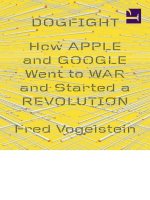Dogfight: How Apple and Google Went to War and Started a Revolution
Bạn đang xem bản rút gọn của tài liệu. Xem và tải ngay bản đầy đủ của tài liệu tại đây (1.31 MB, 578 trang )
*Please note that some of the links refer-
enced in this work are no longer active.
For Evelyn, Sam, and
Beatrice
Contents
Title Page
Copyright Notice
Dedication
Introduction
1. The Moon Mission
2. The iPhone Is Good. Android Will Be
Better.
3. Twenty-Four Weeks, Three Days, and
Three Hours Until Launch
4. I Thought We Were Friends
5. The Consequences of Betrayal
6. Android Everywhere
7. The iPad Changes Everything—Again
8. “Mr. Quinn, Please, Don’t Make Me
Sanction You.”
9. Remember Convergence? It’s Happening
10. Changing the World One Screen at a
Time
A Note on My Reporting
Notes
Acknowledgments
Index
A Note About the Author
Copyright
7/580
Introduction
When Steve Jobs stood before the world at
the beginning of 2007 and said he was going
to reinvent the cell phone, the expectations
were modest—at best. Jobs had upended the
music business with the iPod and iTunes.
But taking on the cell phone industry? That
seemed unlikely. The wireless carriers, who
controlled the market, had been foiling cell
phone innovators for years. And the iPhone,
while cool looking, seemed no match for
their iron grip on the industry. It was more
expensive than most phones out there. And it
was arguably less capable. It ran on a slower
cell/data network. And it required users to
type on a virtual, not a physical, keyboard.
To some critics, that meant the iPhone was
dead on arrival.
If anything, Jobs undersold the iPhone
that day. It truly was a breakthrough. The
iPhone wasn’t really a phone, but the first
mainstream pocket computer that made
calls. With its touchscreen, it did so many
things that other phones could never do that
consumers overlooked its shortcomings.
Consumers got used to the virtual keyboard,
and Apple continued to make it better and
better. It cut the price to equal that of other
phones. It quickly upgraded the slower cell/
data radios to make its technology competit-
ive. It developed displays with unheard-of
resolutions. It bought a chip design company
to make sure the iPhone was always the fast-
est device out there. It rolled out a
9/580
completely new version of the iPhone soft-
ware every year. And it designed iconic tele-
vision ads—as it had done for the iPod—that
made consumers feel special about owning
one.
The subsequent frenzy of demand gave
Apple and Jobs the leverage to turn the
tables on the wireless carriers and start
telling them what to do. More important, it
ignited a technology revolution that today
touches almost every corner of civilization.
The iPhone has become one of the most pop-
ular cell phones of all time, selling more than
135 million units in 2012 alone. It has be-
come the platform for a new and hugely
profitable software industry—phone
apps—that has generated more than $10 bil-
lion in total revenues since starting five years
ago, in 2008. And the iPhone has become
the source of an entire rethink of how hu-
mans interact with machines—with their fin-
gers instead of buttons or a mouse. The
10/580
iPhone and its progeny—the iPod Touch and
the iPad—haven’t just changed the way the
world thinks about cell phones, they have
changed the way the world thinks about
computers for the first time in a generation,
arguably since the advent of the Macintosh
in 1984.
Since 2010, when Jobs followed the
iPhone with the iPad, the questioning has
grown frenzied. Who said our computer had
to sit under our desk or on our lap? Can’t it
just be a screen that fits in our pocket or
purse, or something we leave lying around
the house? Indeed, if you compare iPad sales
to sales of desktops and laptops, Apple is
now the largest PC maker in the world. It
now sells more iPads per quarter than Dell
or HP sells laptops and desktops. Apple’s
total sales of iPhones, iPads, and iPod
Touches now exceed 200 million devices a
year. That’s about the same number of TVs
sold by all manufacturers every year and
11/580
about four times the number of cars sold
worldwide. All of this has turned Apple, the
corporation, into a colossus larger than even
Jobs’s enormous ambitions. Once on the
precipice of bankruptcy, in 1997, Apple today
is one of the most valuable and profitable
companies anywhere.
And yet Apple behaves like a corporation
under siege—because despite all this success,
it is. From the moment in late 2007 that
Google unveiled Android—and its own plan
to dominate the world of mobile phones and
other mobile devices—Google hasn’t just
tried to compete with the iPhone, it has suc-
ceeded in competing with the iPhone.
Android took hold in 2010, and it has ex-
ploded in popularity since. To Apple’s aston-
ishment, there are now more smartphones
and tablets running Android software than
there are iPhones, iPads, and iPod Touches
running Apple’s software, known as iOS. In
2012 there was even debate about whether
12/580
the iPhone was the most popular smart-
phone anymore. During the third quarter of
2012, some surveys said, Samsung sold more
Android-powered Galaxys than Apple sold
iPhones.
Apple ended the “who has the most popu-
lar smartphone” discussion at the end of
2012, when it unveiled the iPhone 5. But
more and more wonder whether this is even
relevant anymore. The differences between
the two platforms are narrowing by the day.
Sure, they are different structurally. Apple
makes every inch of the iPhone—the hard-
ware and the software (though the devices
are assembled in China). Google just makes
the software for Android phones. It allows
phone manufacturers such as Samsung to
make the hardware. But both platforms now
have an equivalent number of pluses and
minuses: Apple’s platform is a little easier to
use, but it only offers three products—the
iPhone, the iPad, and the iPod Touch.
13/580
Google’s platform offers many more phone
choices, and often has the latest phone fea-
tures ahead of Apple, but it lacks the polish
of Apple’s interface. Still, both platforms are
now equally available among large carriers
worldwide, and, with the exception of Apple
stores, they are available for purchase in the
same places.
Seeing Apple’s market dominance chal-
lenged so swiftly and broadly was uniquely
painful for Jobs and remains that way for the
company’s other executives. Jobs thought,
and Apple executives still think, that Google
and the Android community cheated to cre-
ate their success. They think that Google ex-
ecutives stole Apple’s software to build
Android, and that Android’s largest phone
maker, Samsung, copied Apple’s designs to
build its supersuccessful Galaxy phones.
They feel betrayed. Apple and Google weren’t
just business partners when the iPhone was
unveiled in early 2007. They were spiritual
14/580
allies—the yin and yang of the technology re-
volution. This was one of the closest alliances
in American business. Apple made great
devices. Google made great software.
Google’s founders considered Jobs to be a
mentor. Google’s then CEO, Eric Schmidt,
sat on Apple’s board of directors. They had a
common enemy: Microsoft. Together they
planned for a long and prosperous marriage.
Then, as can happen in a marriage, the re-
lationship frayed. Secrets were kept. Prom-
ises were broken. And the two went to war.
When Jobs died in October 2011, there was
hope that the dogfight would feel less like
personal betrayal and quiet down—that
Apple’s new CEO, Tim Cook, would take the
emotion out of the battle and find a way to
settle it. But if anything, Apple has gotten
more aggressive and nasty toward Google
since then. It still has dozens of patent law-
suits in at least seven countries pending
against the Android community—mostly
15/580
against Samsung and Motorola (owned by
Google). In the summer of 2012, it took the
unheard-of step of having its fight with Sam-
sung, Google’s top distributor of Android
phones, tried in front of a jury in San Jose. It
won a $1 billion judgment, though that is be-
ing appealed. In September 2012 Apple
stopped selling the iPhone preloaded with
Google Maps. It replaced the app with one of
its own, despite wide consumer complaints
that the app was inferior. Apple is believed to
be working on a video service to compete
with YouTube, which Google owns.
Apple has even begun replacing some
Google search technology in the iPhone with
search technology from its old enemy, Mi-
crosoft. Now when you use Siri, the iPhone’s
voice recognition feature, Apple’s newest
software no longer uses Google search. In-
stead, she queries Microsoft’s Bing search
engine, which has been clawing at Google for
a decade over search market share. To get
16/580
Siri to use Google’s search, you have to spe-
cifically ask her to “search Google” before
each request. Google is still the default
search engine inside the iPhone’s web
browser. But for those with long memories,
the idea that Apple would dump any Google
technology for Microsoft’s—when Microsoft
was the bitter enemy of both for so long—is
an astonishing development.
Google’s public posture in its fight with
Apple has consistently been “Who, us? We’re
just a bunch of geeks out to change the
world.” But in its quiet, nerdy way Google
has fought back ferociously. It defied Apple’s
demands that it remove software from
Android phones or face patent lawsuits. It
employed tactics to make Jobs look like an
unhinged tyrant. And it bought the cell
phone maker Motorola for $12.5 billion in
2012, its largest acquisition by far. It said the
only purpose of the purchase was to buy Mo-
torola’s patents. It said it would be easier to
17/580
fight a litigious opponent like Apple if it
owned the company that invented the mod-
ern cell phone and all the patents associated
with that. That’s true, but the claim hid an-
other equally powerful reason: the acquisi-
tion means that Google will always be able to
make phones to compete with Apple no mat-
ter how successful Apple is with its lawsuits
against other phone and tablet manufactur-
ers. The purchase also gives Google leverage
in case new challengers emerge.
Last, Google now finds itself doing
something most thought it would never do: it
is making its own consumer electronics from
scratch to compete with Apple devices in the
living room. Google has all the pieces not
only to hook users on cell phones running its
Android software, but to reach them
wherever they go, inside or outside their
homes.
* * *
18/580
Usually, the story of two companies and their
powerful leaders going at it makes a great
magazine piece and little more. Company X
attacks company Y. Company Y fights back.
One wins. One loses. But this is a much big-
ger tale than that. It’s hard to imagine a
more revolutionary object than the object the
two companies started fighting over: the
smartphone. The smartphone has funda-
mentally changed the way humans get and
process information, and that is changing
the world in ways that are almost too large to
imagine. Ponder the individual impacts of
the book, the newspaper, the telephone, the
radio, the tape recorder, the camera, the
video camera, the compass, the television,
the VCR and the DVD, the personal com-
puter, the cell phone, the video game, and
the iPod. The smartphone is all those things
in one device that fits in your pocket. It is
radically changing the way we learn in
school, the way doctors treat patients, the
19/580
way we travel and explore. Entertainment
and all media are accessed in entirely new
ways. That sounds like something Jobs
might have said at one of his famous product
launches. But it is not an exaggeration.
What this means is that Apple versus
Google isn’t just a run-of-the-mill spat
between two rich companies. It is the defin-
ing business battle of a generation. It is an
inflection point, such as the moment when
the PC was invented, when the Internet
browser took hold, when Google reinvented
web search, and when Facebook created the
social network. In this massive reexamina-
tion of how technology, media, and commu-
nications intersect, two of the most powerful
companies in the world to dominate that
new landscape are in open warfare.
Yes, invariably this reminds you of previ-
ous fights among entrepreneurs in Silicon
Valley, such as Apple versus Microsoft in the
1980s or Microsoft versus Netscape in the
20/580
1990s. But the stakes are infinitely higher
now. In the 1980s personal computing was a
nascent market, and both Apple and Mi-
crosoft were new companies. In the 1990s
people saw the potential of the Internet, es-
pecially in a device that fit in your pocket.
But wireless bandwidth was still too slow
and expensive. Today, 1.8 billion cell phones
are sold worldwide every year, and in five to
ten years most of them are going to be
smartphones. No one knows how big the tab-
let market is going to be yet, but the tablet is
already becoming an important new techno-
logy for people to read books, newspapers,
and magazines, not to mention watch TV or
play video games. In other words, the stakes
of this battle are infinitely higher than any
earlier struggles.
It’s not just that there is a lot more money
to be made and lost in the Apple/Google
fight than in previous Silicon Valley battles.
It’s that the fight feels—to the players, at
21/580
least—like a winner-take-all situation. Why?
Because they’re not just fighting over which
side has the hottest devices, they’re battling
for control of the online stores and com-
munities these devices connect to—the so-
called cloud. A lot of what we buy via Apple’s
iTunes store—apps, music, movies, TV
shows, books, etc.—doesn’t work easily on
Android devices or at all, and vice versa. And
both companies know that the more money
each of us spends on apps and other media
from one store, the less likely we are to
switch to the other. They know we will ask,
“Why rebuy all that content just to buy an
Android phone instead of an iPhone?” Many
companies have free apps that work on both
platforms, but even having to redownload
them, and re-set them up, is enough to keep
many users from switching. In Silicon Valley
parlance, it’s a platform war. Whether your
example is Microsoft with Windows and Of-
fice, eBay with auctions, Apple with the iPod,
22/580
Amazon with books, Google with search, or
Facebook with social media, history suggests
that the winner in fights like this gets more
than 75 percent of the market share, while
the loser struggles to stay in that business.
This is a big deal. In the coming years
most of what we consider informa-
tion—news, entertainment, communica-
tions—will get funneled through either
Apple’s or Google’s platform. Doubt me? It’s
already happening. We now spend as much
time connected to the Internet as we do
watching television, and more and more of
our access to the Internet comes through
smartphones and tablets. Think about how
much time you spend staring at your phone
or tablet now—not just responding to email,
reading the news, tweeting, facebooking,
watching a video, playing games, or surfing
the web. Include the seconds you spend in el-
evators, standing in line, at stoplights, in the
restroom too. Now ask yourself this
23/580
question: Who controls what you see on your
television? Your cable company. Who con-
trols what you see on your smartphone? Ul-
timately, it is Apple and Google.
I remember when, as a contributing editor
for Wired, I first started thinking about the
mobile revolution. At that time the top-
selling phones worldwide came from Nokia,
RIM (which makes the BlackBerry), Sony
Ericsson, and Motorola. Then the iPhone
was announced. It quickly seemed inevitable
that Apple and Google would end up fight-
ing. Few agreed with me. An editor friend of
mine said the idea seemed preposterous.
How could Apple and Google compete when
they were in entirely different businesses? he
asked. Technically he was right. Apple makes
money selling the devices it creates. Google
makes money selling online advertising.
What he and many missed is that those are
now only means to a much bigger end. Both
companies see themselves as becoming new
24/580
kinds of content distribution
engines—twenty-first-century TV networks,
if you will. They won’t make content as the
TV networks do today; but their control of
huge global audiences, and their enormous
balance sheets, will enable them to have a
big impact on what gets made and who sees
it.
This may seem counterintuitive. It’s hard
to imagine the geeks at Apple or Google pro-
ducing Mad Men. But makers of movies and
TV shows essentially care about only two
things: How much is their project going to
cost? And how many people are going to see
it? No two companies have more reach than
Apple and Google. Fewer still have more
money. Together they controlled $200 bil-
lion in cash alone by mid-2013. That’s not
only enough to buy and/or finance an unlim-
ited amount of content for their audience;
it’s actually enough to buy most of Holly-
wood. The market capitalizations of News
25/580
Corp., Time Warner, Viacom, and CBS total
that much combined. Although most people
don’t think of Apple and Google as entertain-
ment giants, Apple through iTunes controls
roughly 25 percent of all music purchased
and 6 to 10 percent of the $18 billion home
video market. Meanwhile, Google is invest-
ing millions of dollars in original program-
ming for YouTube, which is already a video
destination for tens of millions of consumers
around the world.
This isn’t to suggest that there won’t be
enormous room for new and old companies
to build substantial businesses of their own
in this new world. In early 2013 Netflix boas-
ted 30 million subscribers, as many as HBO.
Two years ago it looked to be a company that
might not make it. Studios jacked up the
price of their content to unaffordable levels.
Movie and TV-show selection fell and cus-
tomers started to leave. So Netflix—a techno-
logy company based in Los Gatos, not a
26/580









